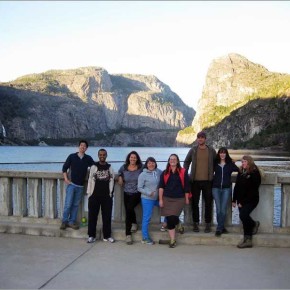San Francisco Water: Environmental Sensibilities v. Environmental History
San Franciscans pride themselves on their progressive environmental sensibilities, but there are tensions between these sensibilities and the city’s environmental history. The story of the city’s quest for water makes this clear.
As San Francisco grew on its narrow, hilly peninsula, the city quickly depleted its artesian aquifers. Once residents polluted the city’s creeks with industrial and domestic waste, the need for water imports was clear. In the early 1860s, the newly-chartered Spring Valley Water Company developed wells in two East Bay farm districts, dammed a coastal stream that drained a wooded watershed on the San Francisco peninsula, and built a 32-mile flume to deliver water northward to San Francisco. The system’s vulnerability was apparent in April 1906, when the earthquake severed the flume and 80% of the city burned.



San Francisco had already begun a search for more abundant and reliable water supplies, culminating in a decade-long battle for federal permission to dam the Tuolumne River in the Hetch Hetchy Valley, within the borders of Yosemite National Park. Congress approved the right-of-way in late 1913; the valley was flooded by 1923. The $100 million project delivered water to San Francisco, via 148 miles of tunnels and pipelines. It continues to serve over 2.5 million people in San Francisco and nearby communities, and to provide hydroelectric power for the city’s airport, hospitals, streetcars and other public utilities.
The Hetch Hetchy project was widely credited with hastening the death of John Muir, the Sierra Club’s founder and the project’s fiercest opponent. It is still contested to this day. In 1987, Secretary of the Interior Donald Hodel proposed decommissioning the dam and restoring Hetch Hetchy Valley to expand recreational opportunities for Yosemite’s visitors. Hodel’s proposal caught The Sierra Club and other longtime foes of the water project off guard; they suspected Hodel was trying to discredit the Left Coast City’s environmentalist opposition to the expansion of offshore oil drilling.
Twenty-five years later, in 2012, San Franciscans rejected by 3:1 a ballot measure compelling the city to replace Hetch Hetchy water and power. Opponents argued that the water, power and fiscal benefits were impossible to replace and that restoring the drowned valley would cost billions in public funding. A group called Restore Hetch Hetchy continues the fight and has filed suit, contending that San Francisco’s water diversions violate the California constitution and that the value of restoring the valley exceeds the cost of moving the city’s Tuolumne River diversion downstream of the park boundary.
The most severe drought in historic times, now in its fourth year, has also called San Francisco’s water use into question. Although per capita consumption is among the lowest in the nation, San Francisco is one of the last coastal cities to adopt wastewater reuse programs, preferring to irrigate lawns and flush toilets with virgin snowmelt and to discharge wastewater to the bay and ocean. This is changing: in 2012, the city adopted an ordinance encouraging non-potable wastewater reuse by commercial, multi-family and mixed-use developments.
Efforts to raze the dam at Hetch Hetchy are not the biggest threat to San Francisco’s water supply. The Hetch Hetchy project, like so much of the California water system, relies on the state’s largest above-ground reservoir: the Sierra snowpack. Yet climate change models predict the Sierra will continue to receive an increasing share of its precipitation as rain rather than as snow, and that snowpack will melt earlier. This will necessitate runoff-capture projects to stabilize supplies. Meanwhile, we should anticipate more frequent droughts.
San Francisco, like every city, remakes the countryside around it. The gold rush city owes its early growth and prosperity to resource extraction. Denuded Sierra landscapes, bay fill, mercury contamination and decimated redwood groves join the drowned Hetch Hetchy valley as legacies of the first century of city-building. While San Franciscans may cherish nature and promote environmental restoration, they curiously “naturalize” Hetch Hetchy water, appreciating its pristine purity and the hydroelectricity it generates en route to the city. The Hetch Hetchy project – controversial, unsustainable – is a complex manifestation of the city’s conflicting progressive environmental sensibilities and its environmental history.
—Nancy Wilkinson
San Francisco State University
Nancy Wilkinson has been a Professor in the Department of Geography & Environment at San Francisco State University since 1986. Her teaching and research focus on California water resources and environmental perception.